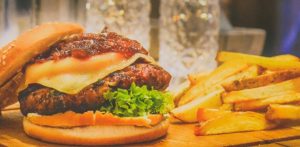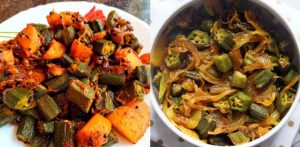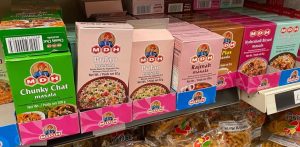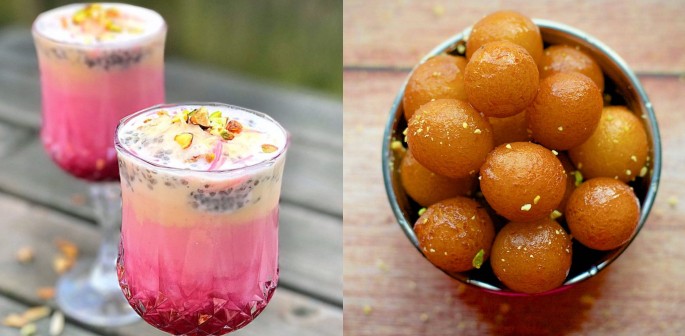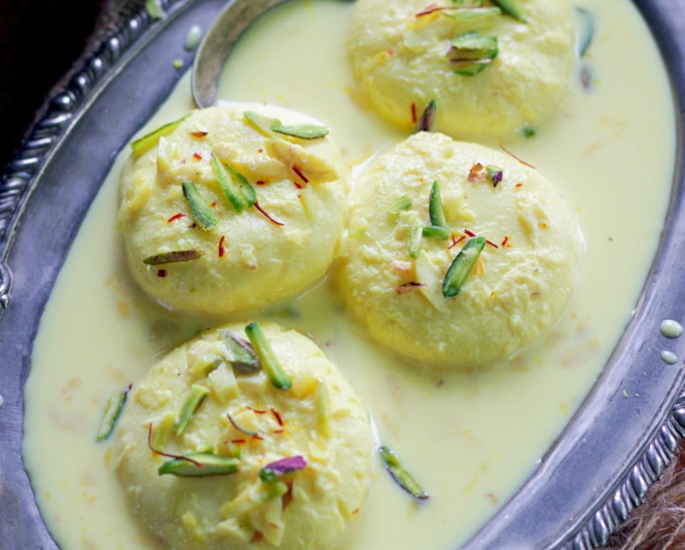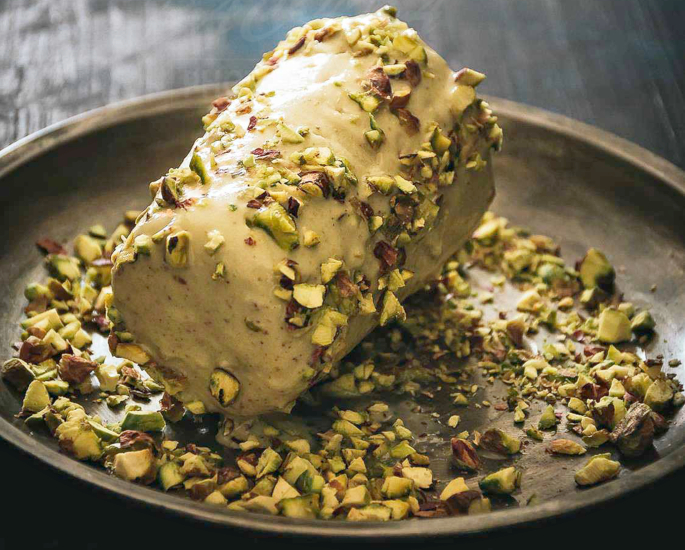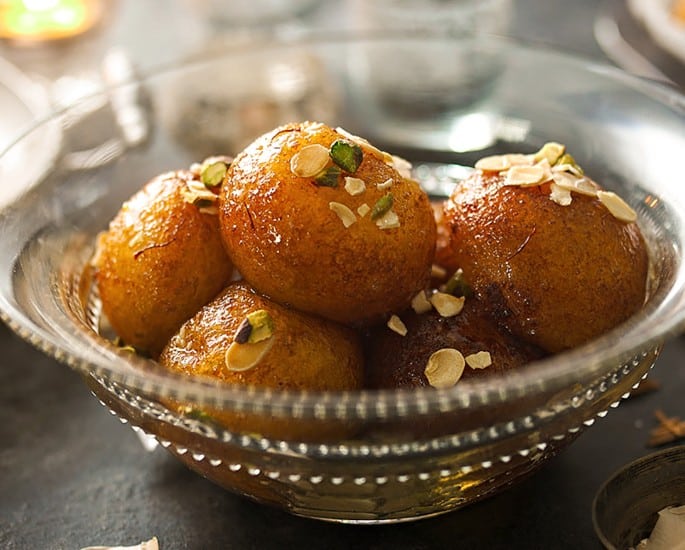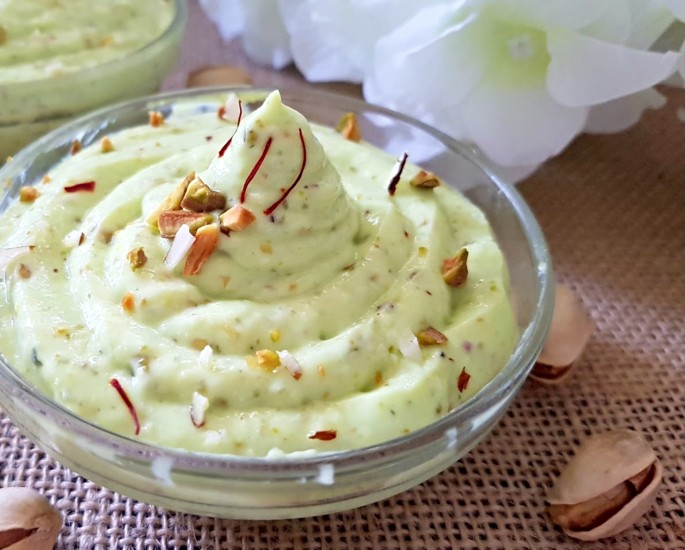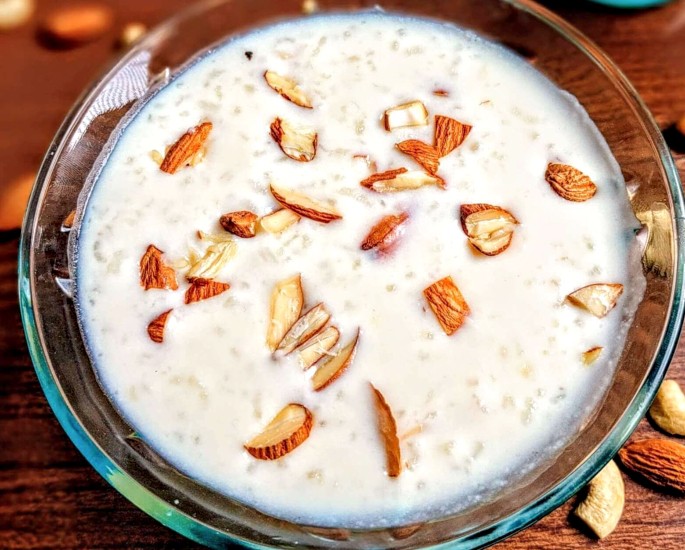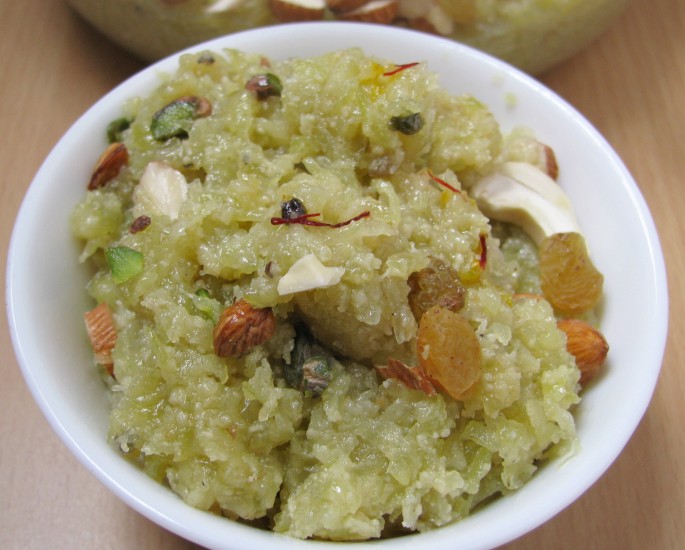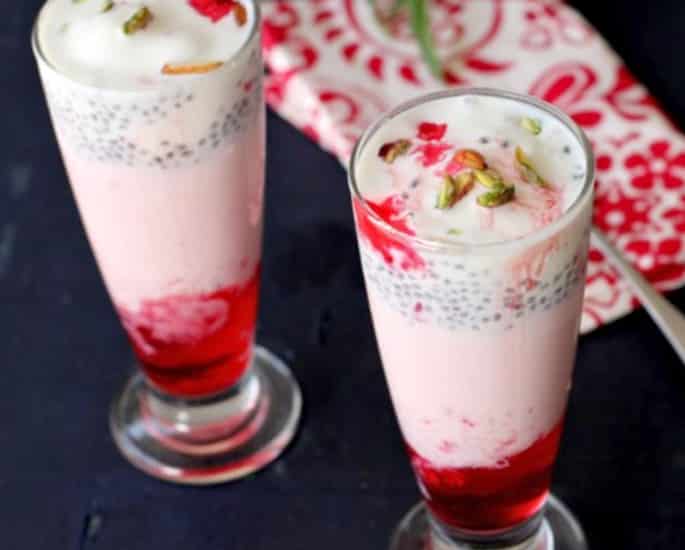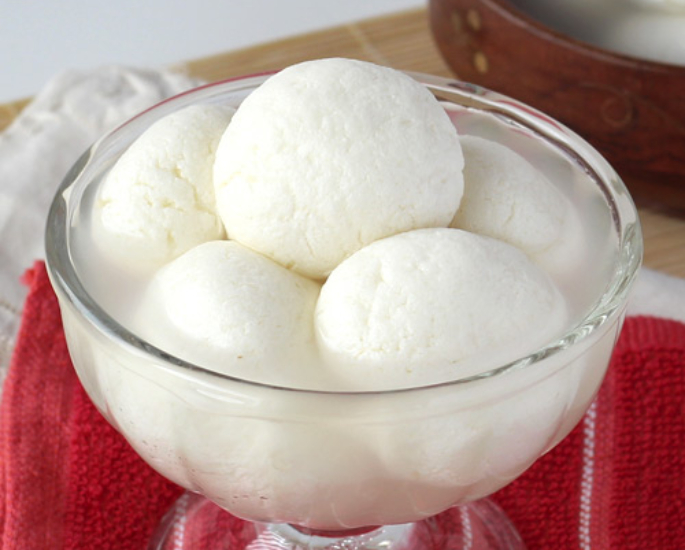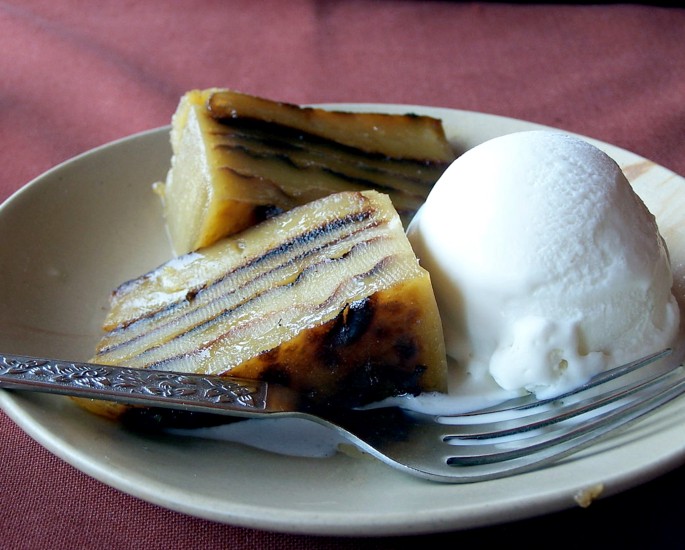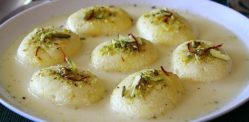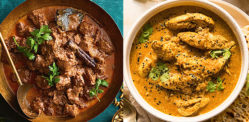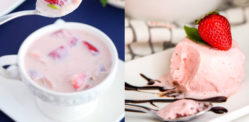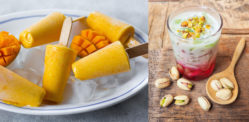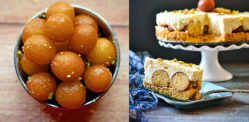It is one of the most enjoyed Indian desserts.
Indian desserts are some of the most unique food creations as they combine numerous ingredients to create a dish which is full of flavour.
They are a very important aspect of Indian culture. To sweeten one’s mouth during special occasions is seen as auspicious.
Their incredible taste and textures have seen them become very popular in a number of regions throughout India.
Some of these desserts have even attracted popularity abroad in countries like the UK, USA, Canada and Europe.
Many are classic Indian sweets and are quickly recognisable, however, making these dishes for yourself will give you the pleasure of creating them in your own kitchen.
Some of these recipes take more time than others so it is advised to prepare some of the steps in advance.
These recipes for Indian desserts will help you make some of the most authentic sweets for you to enjoy.
Ras Malai
Ras malai is a delicious Bengali delicacy and is a mix of sweet creaminess in every mouthful.
It is one of the most enjoyed Indian desserts and it is flattened chana balls which absorbs sweet, thick milk, providing a perfect dessert for sweet lovers.
Ras malai is a dish which needs time to prepare so it is advised to start making this dessert a day in advance to ensure everything is correct.
Every bite is a melt in the mouth moment and it is so delicious, anyone who tries it will want to have more.
Ingredients
- 5 cups Full-fat milk
- 3 tsp lemon juice (mixed with 3 tbsp water)
- 1 Litre iced water
For the Sugar Syrup
- 1 cup Sugar
- ¼ tsp cardamom powder
For the Rabri
- 3 cups Full-fat milk
- ½ cup Sugar
- A pinch of saffron
- 2 tbsp pistachios/almonds, sliced
Method
- Pour three cups of milk and bring to the boil. As it begins to boil, add saffron and sugar. Reduce the heat and stir regularly.
- When a layer of cream forms, move the cream aside. When the milk reduces and becomes thick, set aside to cool.
- Once the milk has cooled, place in the fridge.
- Meanwhile, boil five cups in a pot and add the lemon-water mix. Stir until the milk curdles completely.
- Pour in the ice water and set aside for two minutes.
- Drain the curdled milk in a muslin cloth over a colander. Squeeze the excess whey and make a knot. Leave it to hang for 45 minutes to allow the excess whey to drain off.
- Transfer to a plate and knead well for five minutes until smooth.
- Make equal-sized balls and flatten into discs then set aside.
- Bring three cups of water to a boil with one cup of sugar. Continue stirring until the sugar completely dissolves then add cardamom powder.
- Gently place the discs to the boiling syrup. Cover and cook for eight minutes.
- Remove the discs and place on a plate to cool. Gently squeeze to remove the sugar syrup.
- Remove the milk from the fridge and add the discs to it. Garnish with chopped nuts, chill and serve when desired.
This recipe was inspired by Indian Healthy Recipes.
Kulfi
One of the most refreshing and popular Indian desserts is Kulfi.
It is loved all over India thanks to its silky smooth texture.
The original method is to simmer milk for hours but if you cannot wait to enjoy it, the same creamy effect can be achieved in far less time using condensed milk.
It will still need to be prepared in advance to make sure it has properly chilled.
While there are several delicious flavour options such as mango, this pistachio recipe is a classic flavour which will be one to enjoy.
Ingredients
- 1-litre Full-fat milk
- 200ml condensed milk
- 1 tsp cardamom powder
- 1 tbsp pistachios, chopped
- 3 tbsp pistachios, grounded
- 10 Saffron strands
Method
- Place a heavy bottom saucepan on medium heat. Add the full-fat milk and bring to a boil.
- Remove two tablespoons of the milk from the pan and place in a bowl. Soak the saffron strands in it and set aside.
- As the milk boils, reduce the heat and simmer uncovered, stirring constantly with a silicone spatula.
- Cool the milk for 10 minutes until it reduces and has a thick consistency. Add the condensed milk and quickly stir to mix completely.
- Add the soaked saffron to the milk and mix well. Stir in the ground pistachio and cardamom powder.
- Remove from the heat and leave to cool completely.
- Pour into airtight moulds and freeze for four to six hours. Five minutes before serving, remove from the freezer.
- Remove the kulfi from the moulds and serve with chopped pistachios.
This recipe was inspired by Rachna’s Kitchen.
Gulab Jamun
Gulab Jamuns are popular throughout India and abroad. They are available in most restaurants as a dessert.
The combination of soft jamuns coated in a sticky syrup makes it a fan favourite among dessert lovers.
They can be enjoyed on their own or served with some ice-cream. Both options are equally as delicious.
The sweetness of the syrup is absorbed by the spongy jamuns to create a unique combination of flavour.
Ingredients
- 100g Khoa
- 2 tbsp milk (mixed with a little water)
- 1 tbsp refined flour
- ¼ tsp baking soda
- 2 cups Sugar
- 2 cups Water
- 4 Green cardamoms, slightly crushed
- Ghee
Method
- Mash the khoa until no grains remain and it becomes smooth. Mix in the flour and baking soda. Knead into a firm dough.
- Shape into marble-sized balls (jamuns) and ensure that they have a smooth surface.
- In a karahi, heat the ghee and place the jamuns into it when hot. Fry until golden brown making sure that they do not touch.
- Once done, remove from the karahi and set aside.
- To make the syrup, mix the sugar and water in a pot on low heat, stirring until the sugar dissolves. Once it dissolves, bring it to a boil.
- Add the milk and boil over a high flame without stirring. Skim off any impurities that appear.
- Remove from the heat and leave to cool until slightly thickened.
- Strain the syrup through a muslin cloth. Place back on the heat and add cardamom. Bring to the boil.
- Soak the jamun in the syrup for a minute then remove from the heat.
- Place into a bowl and spread extra syrup over them and enjoy.
This recipe was adapted from NDTV.
Shrikhand
Shrikhand is a very popular Gujarati dessert and it transforms simple yoghurt into a sweet and delicious delicacy.
The yoghurt is flavoured with sugar, cardamom, saffron and chopped nuts or fruit. They come together to create a number of flavours and textures which is why it is thoroughly enjoyed all over India.
It can be served as a standalone dessert or with puri. It involves no cooking and does not take long to make, however, it needs a few hours to chill in the fridge.
This recipe includes cardamom powder and saffron to enhance the taste of the sweet dish.
Ingredients
- 6 cups Plain yoghurt
- 4 cups White sugar
- 1 tsp cardamom powder
- ¼ cup Pistachios, chopped
- ¼ cup Almonds, chopped
- A few saffron strands, soaked in 2 tbsp warm milk
Method
- Tie a muslin cloth over a large bowl and pour the yoghurt onto the cloth. Place into the fridge for three hours to remove any lumps.
- After three hours, remove from the fridge and firmly press the yoghurt with a spoon to release excess liquid.
- Transfer the yoghurt to another bowl. Stir in the saffron milk and add sugar, pistachios, almonds and cardamom.
- Mix well to make sure everything is combined. Refrigerate for one hour or it has completely chilled.
- Remove from the fridge and serve.
This recipe was inspired by All Recipes.
Kheer
Kheer is a creamy rice pudding which is part of many regional cuisines in India.
It is made from milk and uncooked rice which come together along with sugar to create a dessert which is both enjoyable and healthy.
This recipe is flavoured with spices like cardamom and saffron which gives it a unique aroma which fills the room.
It can be enjoyed hot but it tastes best when chilled so it is best to refrigerate it for at least one hour before serving.
Ingredients
- ¼ cup Basmati rice
- 4 cups Full-fat milk
- ¼ cup Warm milk
- ½ cup Sugar
- 2 Bay leaves
- ¼ tsp cardamom powder
- ¼ cup cashew nuts, almonds & pistachios, chopped
- A pinch of saffron
Method
- Wash and soak the rice for 30 minutes. Drain and set aside.
- Combine the saffron and warm milk in a bowl, mix well and set aside.
- In a deep non-stick pan boil the milk on a medium flame for eight minutes. Add the rice, gently stir to combine and cook on medium heat for 20 minutes, stirring occasionally.
- Add the sugar, bay leaves, cardamom powder and saffron milk. Mix well and cook for four minutes while stirring continuously.
- Remove from the heat, discard the bay leaves and add the mixed nuts. Mix well.
- Place in the fridge for at least one hour and serve chilled.
This recipe was inspired by Tarla Dalal.
Halwa
This classic Indian dessert is popular among sweet tooths, especially in Gujarat where it originates.
It has a pudding-like texture and is slightly sweet but it is very creamy.
This recipe is called ‘Doodhi Halwa’ and it uses milk gourd which is typically used to make savoury dishes but when combined with ghee and cardamom pods, it creates a mouth-watering sweet dish.
The flavours and textures are unlike any other Indian dessert as the plain-tasting milk gourd becomes much more with the other ingredients.
Ingredients
- 6 tbsp ghee
- 4 cups Milk gourd, skin peeled, seeds removed and grated
- 1 cup Khoa
- 2 cans Sweetened condensed milk
- ½ cup Almonds, blanched and cut into slivers
- 5 Green cardamom pods, powdered with a teaspoon of sugar in a pestle and mortar.
Method
- In a heavy-bottomed pan, heat the ghee on a medium flame. When hot, add the milk gourd and stir until it turns transparent.
- Add the khoa, mix well and cook for five minutes. Add the condensed milk and cardamom powder and mix well.
- Cook until most of the moisture has evaporated and it becomes thick in consistency while stirring regularly to prevent burning.
- Once cooked, remove from the heat and allow it to cool. Garnish with the almond slivers and serve.
This recipe was inspired by The Spruce Eats.
Falooda
While the most common version comes from North India, falooda or faluda has progressively become popular in places like the UK.
It is served cold and is made with boiled vermicelli, rose syrup, ice-cream and milk.
The cool dessert is then served in tall glasses, resembling western style sundaes. Its popularity has seen ready-to-make kits in Asian supermarkets.
You will need to plan in advance but the effort will be worth it when you enjoy a refreshing glass.
Ingredients
- 1½ cups Milk
- 2 tbsp sugar
- 2 tsp basil seeds
- A handful of vermicelli (sev)
- 2 tbsp rose syrup
- 2 scoops of vanilla or strawberry ice-cream
- Pistachios, chopped
- Rose petals
Method
- Soak the basil seeds in water for at least 30 minutes. Once done, drain them.
- Meanwhile, bring the milk and sugar to a boil in a pan on a medium flame. When it comes to a boil, lower the heat and simmer for seven minutes.
- Once done, remove from the heat and place in the fridge to chill.
- To make the sev, boil some water in a pan then add the sev. Cook for five minutes. Once done, drain and rinse with cold water to stop further cooking. Cut into small pieces.
- To assemble the falooda, take two glasses and add a spoonful of basil seeds in each. Then add the cooked sev. Add a tablespoon of rose syrup in each glass.
- Pour the milk in each glass then add a scoop of ice-cream or kulfi.
- Garnish with chopped pistachios and rose petals. Serve immediately.
This recipe was inspired by Spice Up the Curry.
Rasgulla
These are one of the most popular Indian desserts originating in West Bengal though it is debated that it originated in Odisha.
The spongy white rasgulla balls are made from cottage cheese, semolina and sugar syrup. The sugar syrup is absorbed by the dumplings to create a delicious and sweet dessert.
It is loaded with sweetness and because they are light, they have become a favourite throughout India.
Ingredients
- 1 Litre full-fat milk
- 3 tbsp lemon juice
- 1 tsp cornflour
- 4 cups Water
- 1 Cup sugar
Method
- In a deep pan heat milk and bring to the boil.
- As it begins to boil, remove from the heat to cool and add half a cup of water. Add lemon juice and stir until the milk has curdled.
- Drain the curdled milk using a muslin cloth. Squeeze to remove any excess liquid. This leaves you with the chena (Indian cottage cheese).
- Place the chena on a plate and add cornflour. Mix the chena and cornflour using your hands for 10 minutes.
- Form into small balls of roughly the same size.
- To make the syrup, mix the water and sugar together in a pan until it begins to boil. Place the rasgulla balls into the syrup.
- Allow it to cook for 20 minutes.
- Once cooked, leave it to cool, then refrigerate. Serve once cool.
This recipe was adapted from Cook with Manali.
Soan Papdi (Patisa)
Soan Papdi is a north Indian dessert which will melt in your mouth thanks to its flaky and light texture. It is also known as Patisa.
It uses sugar syrup, ghee, milk and a mixture of gram and refined flour to give it a burst of sweet flavour. It is not too sweet though as the crunchy texture balances out the flavour.
To make the dessert even more flavourful, use crushed green cardamom and an array of chopped nuts. Not only does the flavour become better but it is also more appealing.
It can be a difficult dish to make as an intensive process is needed to give it its fluffy texture.
Ingredients
- 1¼ cup Gram flour
- 1¼ cup Refined flour
- 250g ghee
- 1½ cup Water
- 2 tbsp milk
- 2½ cup Sugar
- ½ tsp green cardamom, slightly crushed
Method
- Sift the gram flour and refined flour into a large bowl.
- Heat a large saucepan over a medium flame. Once hot add ghee then add the flour mixture and roast until lightly golden.
- Set aside to cool while stirring occasionally.
- Meanwhile, heat sugar, milk and water in a pot and bring to the boil. When it has thickened, pour the sugar syrup into the flour mixture and beat with a large fork until the mixture forms threadlike flakes.
- Pour the mixture into a greased surface and roll lightly until it is one-inch in thickness.
- Sprinkle the cardamom and gently press down using the palm of your hand.
- Leave it to cool then cut into one-inch squares. Wrap each piece into square pieces of thin plastic sheet.
- Store in an airtight container and serve.
This recipe was inspired by Times of India.
Bebinca
Bebinca is a pudding with a cake-like appearance and it is especially enjoyed in Goa where it originated.
It is made of plain flour, coconut milk, sugar, ghee and egg yolk. What makes this dessert so unique is its layered arrangement.
Usually, it has seven layers but it can have up to 16 layers in total and it is soft and sweet. It can be enjoyed on its own but a scoop of ice-cream intensifies its taste.
Bebinca is a dish which requires patience as an additional layer cannot be included before preparing the other layer.
Ingredients
- 250g plain flour
- 700ml coconut milk
- 24 Egg yolks
- 2 cups Sugar
- 1½ cups Ghee
- Almond slivers (to garnish)
Method
- In a bowl, mix the coconut milk and sugar together until the sugar has dissolved.
- In another bowl, whisk the egg yolks until they become creamy. Add the coconut milk and mix well. Gradually add the flour to the mixture to ensure that there are no lumps.
- Meanwhile, preheat the grill to medium.
- Put a tablespoon of ghee in a baking pan that is at least six inches deep. Place under the grill until the ghee melts.
- Once the ghee has melted, remove from the grill and pour some of the batter to form a quarter inch thick layer.
- Place into the grill and cook until the top is golden.
- Once done, remove from the grill and add another tablespoon of ghee onto the layer.
- Pour another layer of batter of the same thickness as the previous one. Grill until golden.
- Repeat the process until all the batter has been used up.
- When you reach the last layer, spoon the final tablespoon of ghee and grill.
- When done, remove from the grill and turn the bebinca over on a flat dish and garnish with almond slivers.
- Cut into equal slices and serve warm or cool.
This recipe was inspired by The Spruce Eats.
Making any of these Indian desserts will give you the delightful experience of making them for and your friends and family to enjoy.
Desi sweet lovers will certainly savour the chance of trying as many of these as possible!
While many of these can be bought from a shop making them yourself will allow you to manage the ingredients, and of course, create an authentic dish all by yourself.






















